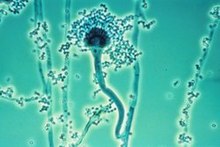| Aspergillus fumigatus | |
|---|---|

| |
| Scientific classification | |
| Domain: | Eukaryota |
| Kingdom: | Fungi |
| Division: | Ascomycota |
| Class: | Eurotiomycetes |
| Order: | Eurotiales |
| Family: | Aspergillaceae |
| Genus: | Aspergillus |
| Species: | A. fumigatus
|
| Binomial name | |
| Aspergillus fumigatus Fresenius 1863
| |
| Synonyms | |
|
Neosartorya fumigata | |
Aspergillus fumigatus is a species of fungus in the genus Aspergillus, and is one of the most common Aspergillus species to cause disease in individuals with an immunodeficiency.
Aspergillus fumigatus, a saprotroph widespread in nature, is typically found in soil and decaying organic matter, such as compost heaps, where it plays an essential role in carbon and nitrogen recycling.[1] Colonies of the fungus produce from conidiophores; thousands of minute grey-green conidia (2–3 μm) which readily become airborne. For many years, A. fumigatus was thought to only reproduce asexually, as neither mating nor meiosis had ever been observed. In 2008, A. fumigatus was shown to possess a fully functional sexual reproductive cycle, 145 years after its original description by Fresenius.[2] Although A. fumigatus occurs in areas with widely different climates and environments, it displays low genetic variation and a lack of population genetic differentiation on a global scale.[3] Thus, the capability for sex is maintained, though little genetic variation is produced.
The fungus is capable of growth at 37 °C or 99 °F (normal human body temperature), and can grow at temperatures up to 50 °C or 122 °F, with conidia surviving at 70 °C or 158 °F—conditions it regularly encounters in self-heating compost heaps. Its spores are ubiquitous in the atmosphere, and everybody inhales an estimated several hundred spores each day; typically, these are quickly eliminated by the immune system in healthy individuals. In immunocompromised individuals, such as organ transplant recipients and people with AIDS or leukemia, the fungus is more likely to become pathogenic, over-running the host's weakened defenses and causing a range of diseases generally termed aspergillosis. Due to the recent increase in the use of immunosuppressants to treat human illnesses, it is estimated that A. fumigatus may be responsible for over 600,000 deaths annually with a mortality rate between 25 and 90%.[4] Several virulence factors have been postulated to explain this opportunistic behaviour.[5]
When the fermentation broth of A. fumigatus was screened, a number of indolic alkaloids with antimitotic properties were discovered.[6] The compounds of interest have been of a class known as tryprostatins, with spirotryprostatin B being of special interest as an anticancer drug.
Aspergillus fumigatus grown on certain building materials can produce genotoxic and cytotoxic mycotoxins, such as gliotoxin.[7]
- ^ Fang W, Latgé JP (August 2018). "Microbe Profile: Aspergillus fumigatus: a saprotrophic and opportunistic fungal pathogen". Microbiology. 164 (8): 1009–1011. doi:10.1099/mic.0.000651. PMC 6152418. PMID 30066670.
- ^ O'Gorman CM, Fuller H, Dyer PS (January 2009). "Discovery of a sexual cycle in the opportunistic fungal pathogen Aspergillus fumigatus". Nature. 457 (7228): 471–4. Bibcode:2009Natur.457..471O. doi:10.1038/nature07528. PMID 19043401. S2CID 4371721.
- ^ Rydholm C, Szakacs G, Lutzoni F (April 2006). "Low genetic variation and no detectable population structure in aspergillus fumigatus compared to closely related Neosartorya species". Eukaryotic Cell. 5 (4): 650–7. doi:10.1128/EC.5.4.650-657.2006. PMC 1459663. PMID 16607012.
- ^ Dhingra S, Cramer RA (2017). "Regulation of Sterol Biosynthesis in the Human Fungal Pathogen Aspergillus fumigatus: Opportunities for Therapeutic Development". Frontiers in Microbiology. 8: 92. doi:10.3389/fmicb.2017.00092. PMC 5285346. PMID 28203225.
- ^ Abad A, Fernández-Molina JV, Bikandi J, Ramírez A, Margareto J, Sendino J, et al. (December 2010). "What makes Aspergillus fumigatus a successful pathogen? Genes and molecules involved in invasive aspergillosis" (PDF). Revista Iberoamericana de Micologia. 27 (4): 155–82. doi:10.1016/j.riam.2010.10.003. PMID 20974273.
- ^ Cui CB, Kakeya H, Osada H (August 1996). "Spirotryprostatin B, a novel mammalian cell cycle inhibitor produced by Aspergillus fumigatus". The Journal of Antibiotics. 49 (8): 832–5. doi:10.7164/antibiotics.49.832. PMID 8823522.
- ^ Nieminen SM, Kärki R, Auriola S, Toivola M, Laatsch H, Laatikainen R, et al. (October 2002). "Isolation and identification of Aspergillus fumigatus mycotoxins on growth medium and some building materials". Applied and Environmental Microbiology. 68 (10): 4871–5. Bibcode:2002ApEnM..68.4871N. doi:10.1128/aem.68.10.4871-4875.2002. PMC 126391. PMID 12324333.